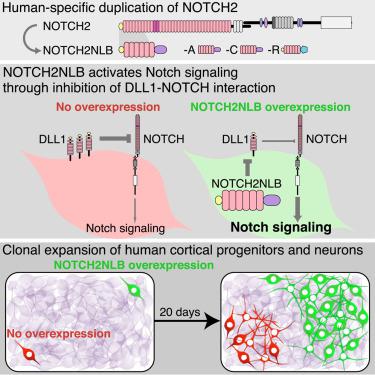Our official English website, www.x-mol.net, welcomes your
feedback! (Note: you will need to create a separate account there.)
Human-Specific NOTCH2NL Genes Expand Cortical Neurogenesis through Delta/Notch Regulation.
Cell ( IF 45.5 ) Pub Date : 2018-May-31 , DOI: 10.1016/j.cell.2018.03.067
Ikuo K. Suzuki , David Gacquer , Roxane Van Heurck , Devesh Kumar , Marta Wojno , Angéline Bilheu , Adèle Herpoel , Nelle Lambert , Julian Cheron , Franck Polleux , Vincent Detours , Pierre Vanderhaeghen
Cell ( IF 45.5 ) Pub Date : 2018-May-31 , DOI: 10.1016/j.cell.2018.03.067
Ikuo K. Suzuki , David Gacquer , Roxane Van Heurck , Devesh Kumar , Marta Wojno , Angéline Bilheu , Adèle Herpoel , Nelle Lambert , Julian Cheron , Franck Polleux , Vincent Detours , Pierre Vanderhaeghen

|
The cerebral cortex underwent rapid expansion and increased complexity during recent hominid evolution. Gene duplications constitute a major evolutionary force, but their impact on human brain development remains unclear. Using tailored RNA sequencing (RNA-seq), we profiled the spatial and temporal expression of hominid-specific duplicated (HS) genes in the human fetal cortex and identified a repertoire of 35 HS genes displaying robust and dynamic patterns during cortical neurogenesis. Among them NOTCH2NL, human-specific paralogs of the NOTCH2 receptor, stood out for their ability to promote cortical progenitor maintenance. NOTCH2NL promote the clonal expansion of human cortical progenitors, ultimately leading to higher neuronal output. At the molecular level, NOTCH2NL function by activating the Notch pathway through inhibition of cis Delta/Notch interactions. Our study uncovers a large repertoire of recently evolved genes active during human corticogenesis and reveals how human-specific NOTCH paralogs may have contributed to the expansion of the human cortex.
中文翻译:

人类特定的NOTCH2NL基因通过Delta / Notch调节扩展了皮质神经发生。
在最近的人类发展过程中,大脑皮层经历了快速扩张并增加了复杂性。基因重复构成了主要的进化力量,但是它们对人脑发育的影响仍然不清楚。使用量身定制的RNA测序(RNA-seq),我们分析了人类胎儿皮层中人特异性复制(HS)基因的时空表达,并鉴定了35个HS基因的全部组成,这些基因在皮质神经发生过程中表现出强大而动态的模式。其中NOTCH2NL是NOTCH2受体的人类特异性旁系同源物,因其促进皮层祖细胞维持的能力而脱颖而出。NOTCH2NL促进人类皮质祖细胞的克隆扩增,最终导致更高的神经元输出。在分子水平上 NOTCH2NL通过抑制顺式Delta / Notch相互作用激活Notch途径发挥功能。我们的研究揭示了在人类皮质形成过程中活跃的最近进化基因的大量组成部分,并揭示了人类特异性的NOTCH旁系同源物可能如何促进人类皮质的扩张。
更新日期:2018-05-31
中文翻译:

人类特定的NOTCH2NL基因通过Delta / Notch调节扩展了皮质神经发生。
在最近的人类发展过程中,大脑皮层经历了快速扩张并增加了复杂性。基因重复构成了主要的进化力量,但是它们对人脑发育的影响仍然不清楚。使用量身定制的RNA测序(RNA-seq),我们分析了人类胎儿皮层中人特异性复制(HS)基因的时空表达,并鉴定了35个HS基因的全部组成,这些基因在皮质神经发生过程中表现出强大而动态的模式。其中NOTCH2NL是NOTCH2受体的人类特异性旁系同源物,因其促进皮层祖细胞维持的能力而脱颖而出。NOTCH2NL促进人类皮质祖细胞的克隆扩增,最终导致更高的神经元输出。在分子水平上 NOTCH2NL通过抑制顺式Delta / Notch相互作用激活Notch途径发挥功能。我们的研究揭示了在人类皮质形成过程中活跃的最近进化基因的大量组成部分,并揭示了人类特异性的NOTCH旁系同源物可能如何促进人类皮质的扩张。

































 京公网安备 11010802027423号
京公网安备 11010802027423号